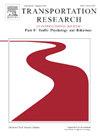The older persons warning sign and its effect on driver behaviour
IF 3.5
2区 工程技术
Q1 PSYCHOLOGY, APPLIED
Transportation Research Part F-Traffic Psychology and Behaviour
Pub Date : 2025-05-03
DOI:10.1016/j.trf.2025.04.030
引用次数: 0
Abstract
Road signs are there to inform or warn drivers and help drivers to select appropriate speeds and be appropriately aware for hazards. The “older person” warning sign is used in many countries, placed near older people’s homes and schools, to warn drivers of potentially vulnerable older pedestrians in the vicinity. The sign often depicts a silhouette of an older couple hunched over within a warning triangle and is a rather negative stereotype of older people. It is questionable whether this sign is useful in slowing drivers down, especially given the potential of the sign to reinforce negative stereotypes. This study used a Driving Simulator to determine whether the “older person” warning sign makes any useful difference to driver behaviour. Drivers were randomly allocated into a group that observed a “older person” warning sign (n = 20) and a group that saw a generic pedestrian warning sign (n = 20). The drivers in the “older person” warning sign group did not alter their speed or braking when observing the sign, regardless of age and gender. The drivers in the pedestrian warning sign group did significantly reduce their speed and used braking when seeing the sign. The “older person” warning sign made no difference to significant driver behaviour and it is suggested it should be removed or replaced by the pedestrian sign.
老年人警告标志及其对驾驶员行为的影响
道路标志的存在是为了通知或警告司机,帮助司机选择适当的速度,并适当地意识到危险。许多国家都使用“老年人”警告标志,放置在老年人的家和学校附近,以警告司机注意附近可能易受伤害的老年行人。这种标志通常描绘的是一对老夫妇驼背在一个警告三角形内的剪影,这是对老年人的一种相当负面的刻板印象。这个标志是否有助于让司机减速值得怀疑,尤其是考虑到这个标志有可能强化负面的刻板印象。这项研究使用了驾驶模拟器来确定“老年人”警告标志是否对驾驶员的行为有任何有用的影响。司机被随机分配到看到“老年人”警告标志的一组(n = 20)和看到普通行人警告标志的一组(n = 20)。无论年龄和性别,“老年人”组的司机在看到警告标志时都没有改变速度或刹车。看到行人警告标志组的司机在看到标志时确实显著降低了车速并使用了刹车。“老年人”警告标志对司机的重大行为没有影响,建议将其移除或替换为行人标志。
本文章由计算机程序翻译,如有差异,请以英文原文为准。
求助全文
约1分钟内获得全文
求助全文
来源期刊
CiteScore
7.60
自引率
14.60%
发文量
239
审稿时长
71 days
期刊介绍:
Transportation Research Part F: Traffic Psychology and Behaviour focuses on the behavioural and psychological aspects of traffic and transport. The aim of the journal is to enhance theory development, improve the quality of empirical studies and to stimulate the application of research findings in practice. TRF provides a focus and a means of communication for the considerable amount of research activities that are now being carried out in this field. The journal provides a forum for transportation researchers, psychologists, ergonomists, engineers and policy-makers with an interest in traffic and transport psychology.

 求助内容:
求助内容: 应助结果提醒方式:
应助结果提醒方式:


